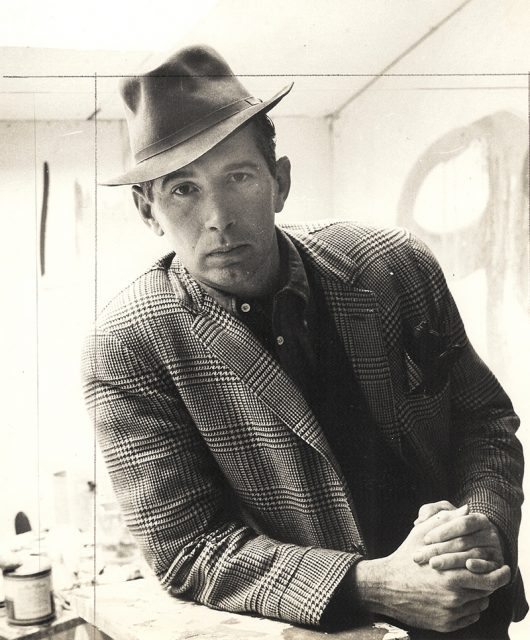Winter 2016
Between the Studio and the Bulldozer
George Dunbar is a painter and sculptor, best known for his work in metal leaf, and clay. His work marries the stark geometry of modern art with lush, elemental materials, which call forth Louisiana's distinctive local landscape.
Published: December 9, 2016
Last Updated: February 8, 2019

Images courtesy of New Orleans Museum of Art. Far right photo by Will Crocker.
(From left to right) Untitled, Red M, and Coin du Lestin by George Dunbar.
New Orleans native George Dunbar studied in Philadelphia and New York before returning to Louisiana in the 1950s to create paintings, sculptures, assemblages and prints. His work marries the stark geometry of modern art with lush, elemental materials, including clay and gold leaf, which call forth Louisiana’s distinctive local landscape.With “George Dunbar: Elements of Chance,” the New Orleans Museum of Art (NOMA) presents the first comprehensive retrospective for this pioneering Louisiana modernist. Born in 1927, Dunbar played a pivotal role in introducing abstract art to the South—and he continues his studio explorations today.
The NOMA exhibition gathers more than 40 works, tracing the evolution of Dunbar’s art from his early paintings of the 1940s and 1950s to his most recent work in clay relief. Dunbar’s richly textured works explore abstract art’s connection to landscape and place, and his unique vision for abstraction highlights Louisiana’s pivotal—if widely underestimated—role in the broader story of 20th-century American art.
“George Dunbar’s work truly helped create a context and place for contemporary art in New Orleans,” said Katie A. Pfohl, curator of modern and contemporary art at NOMA. “In the 1950s and 1960s, he introduced New Orleans to vanguard ideas, experimenting with the relationship between accident and intention, and embracing elements of chance in his art-making in ways that were brand-new for most artists in New Orleans at the time.”

Courtesy of New Orleans Museum of Art
Although best known for his work in metal leaf and clay, Dunbar began his career as a painter. While taking classes at the Tyler School of Art in Philadelphia and visiting New York on the weekends, Dunbar encountered the “action paintings” of the New York School. The bold, abstract paintings of artists like Jackson Pollock, Franz Kline and Willem de Kooning inspired Dunbar to embrace a more gestural, intuitive approach to his art. As a young artist, Dunbar often spent hours on a painting only to find a more perfect composition in the spilled paint and discarded scraps of paper on his studio floor. Fascinated by these unintentional, chance compositions, he often collaged them into his early paintings.
Dunbar’s passion for earthy materials like metal leaf and clay came in large part from his work as a land developer, a profession he pursued in tandem with art-making for his entire career. Spending his days with a dragline and a bulldozer on the bayou, and his nights poring over new compositions in the studio, the practices subtly merged. The titles for his most famous series of works, “Coin du Lestin,” come from the name of one of his land development projects in Slidell. Both his early “Coin du Lestin” artworks and his plans for his development sites reflect a similar reverence for the natural properties of earth and element.
As with his art, Dunbar approached his development sites with no preconceived map or plan, letting the subtleties of earth, elevation and vista dictate the placement of roads and canals. He created entire neighborhoods improvisationally, letting, as he says, “the bulldozer make the curve.”
Still active in the studio, Dunbar continues to embrace risk and cultivate chance effects. “I think it’s very dangerous to have a favorite painting,” Dunbar said in the catalog for the NOMA exhibition. “If you decide to go through your life as an artist, you need to always feel like you can do better, or you’ll stop. If I had a favorite painting, then I wouldn’t still be working as hard as I do!”
“George Dunbar: Elements of Chance” will be accompanied by a limited-edition artist book and catalogue created in collaboration with George Dunbar, which contains an in-depth interview with the artist by Susan M. Taylor, NOMA’s Montine McDaniel Freeman director, and an essay by Katie A. Pfohl that contextualizes Dunbar’s work within the rich history of 20th-century American art.
“George Dunbar: Elements of Chance” is organized by NOMA and is supported in part by Michele Reynoir and Kevin Clifford, Kitty and Stephen Sherrill, Donna Perret Rosen and Benjamin M. Rosen, and Mr. and Mrs. Thomas B. Lemann. Additional support is provided by the family of Eugenie Huger in her memory, Pia and Malcolm Ehrhardt, Elizabeth and Chip Goodyear, and Basi and Michael Carbine.

